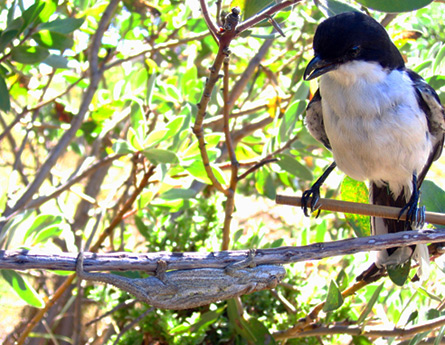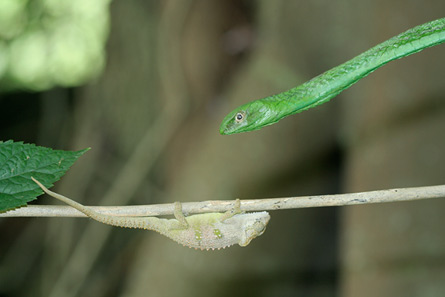A dwarf chameleon doesn’t just change color. It changes the way it changes color — depending on whom it’s hiding from.


Snakes literally make a dwarf chameleon turn pale, says Devi Stuart-Fox of the University of Melbourne in Australia. A bird, though, inspires the chameleon to step up its game and make a more precise match with the twig to which it’s clinging.
Despite all that effort for the bird, though, the chameleon’s trickery hides them better from the snake, Stuart-Fox and her colleagues also report in an upcoming Biology Letters.
The chameleons’ quick-change artistry reveals a new example of animals tailoring their defenses to particular predators. Theorists have predicted that such predator-specific defenses are relatively rare, says Keri Langridge of University of Sussex in Brighton, England. An animal should be more likely to evolve a one-size-pretty-much-fits-all defense, since a fine-tuned response to one kind of threat could easily become the wrong thing to do when a different kind of threat looms. Counterexamples are turning up, though, as researchers try to explore multiple menaces in an animal’s environment. “There is a growing emphasis on a more holistic approach to studies of antipredator behavior,” Langridge says.
The dwarf chameleon Bradypodion taeniabronchum lives in the shrubby heathlands of South Africa, with predatory birds and snakes aplenty. To test the chameleon’s camouflage, Stuart-Fox had a museum model maker create a fake snake resembling the boomslang, a venomous hunter that winds through shrubbery looking for just such snacks as chameleons. For a bird, the researchers chose a fiscal shrike that had been stuffed. “It’s quite famous for taking the chameleons and impaling them on thorns,” Stuart-Fox says.
Chameleons were easier to catch at night, since they lose control of color matching while sleeping, the researchers found. In daylight, the researchers gave the temporarily captive chameleons a look at the fake predators from varying angles. The chameleons flipped to the opposite side of their perch, sucking in their bodies as if trying to slim down enough to hide behind a twig.
Stuart-Fox took color measurements of the hiding chameleons and compared them to the twig. Her calculations show that chameleons hiding from birds shifted closer to twig color. But the chameleons went several shades paler at the sight of the boomslang. “The snake would normally be looking up at them against the sky,” Stuart-Fox says. The paler hue doesn’t necessarily match the sky color, but the researchers’ analysis of predator vision suggests it makes the chameleon harder to see against the glare of sunlight. And snakes’ vision cannot judge hues as well as birds, she says.






